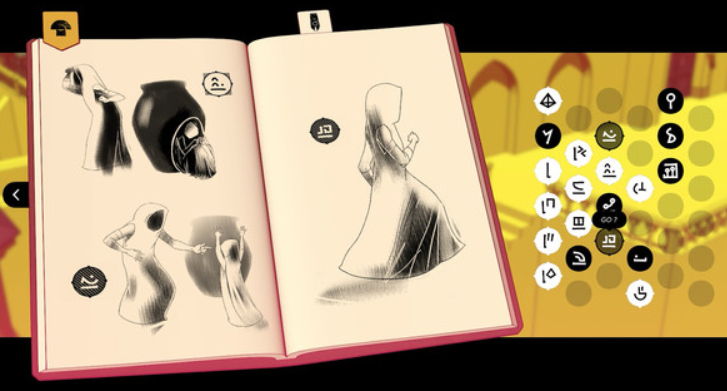When I first started playing Chants of Sennaar on Steam, I said “uh oh,” thinking it would be a game that suggested language learning was all about immersion and guessing. Luckily, I was wrong.
“Legend says that one day, a traveler will reunite the Peoples of the Tower who are unable to communicate with each other. Observe, listen, and decipher ancient languages in a fascinating universe inspired by the myth of Babel.”
The basic gameplay is you moving about the world and clicking on things to interact with, like puzzles, or other humanoids, as you’re shown glyphs. The point is to learn the glyphs and progress throughout the narrative. While the game certainly has an inductive element to learning those glyphs, you eventually get what you need: comprehension. And it’s full comprehension, too, not just that “gist” stuff that only gets you so far. The game gives you comprehended input.
But how? Using a journal to keep track of glyphs you encounter, you have the option click on any of them (shown to the right of the screenshot) and add short notes, like guessing what you think it means. Now, if things ended here, it’d be a frustrating gaming experience that felt like a lot of work, and was also a bad representation of language learning. Sound familiar to what’s been happening in language classrooms for centuries?! Instead, once you encounter a certain number of glyphs, new pages appear (shown to the left of the screenshot) that allow you to drag and drop the glyph circles onto a few images to validate a glyph’s meaning. When you correctly identify all the page’s glyphs with their image, they become validated and you are presented with the actual meaning of the glyphs.
That’s “establishing meaning.”
Every time you encounter those same glyphs throughout the game, you’re now shown the English meaning (if you hover over them) as you read new messages that point you towards what to do next. Any glyphs that you haven’t had confirmed (i.e., validated) still appear as ellipses. And that’s key to deciphering language in this game: the confirmation of your guesses. When that happens, you get CI.
Same with language teaching and learning.
So, the learner might have some guesses, but only truly gets CI once their guesses are confirmed. In class, this could be the teacher confirming the meaning—but also the teacher actively seeking that out—or a glossary in a novella that the student uses to confirm their guesses (or flat out confusion).
The game also highlights common drawbacks to immersion-insistent language teaching, like only using gestures, observation, and images to establish meaning. For example, I thought one glyph meant one thing, but when I dragged it to get validated nothing happened. I was wrong. This just means that I was on the wrong track, and my interactions with things in the game weren’t enough yet to give me a sense of what that particular glyph meant. It turns out that I just needed more of those interactions, and I also needed the game to confirm that meaning for me. That’s what a teacher needs to do—either tell students what language means, or provide them with simple resources to do so on their own (i.e., glossary). For me, it wasn’t until the validating point that I learned a more refined meaning of the word I was guessing (i.e., my guess wasn’t even totally accurate because I was making up the meaning on my own, which is an unreliable way to learn a language).
Now, I’ve played Chants of Sennaar for about 1.2 hours so far. One thing I can say is that from a language learning perspective, I haven’t discovered the meaning of very many glyphs, and these glyphs comprise very short messages. In other words, there’s not much input. And that’s fine, because language acquisition isn’t the point of this game, yet this does provide insight into language teaching and learning. That is, spending 1.2 hours to learn a few words that don’t show up very much is not efficient. Teachers should not be running their classes like a guessing game (especially if confirmation of meaning is withheld in immersion-like settings, unlike Chants of Sennaar).
Pedagogical Implications
a more effective way to learn language is to have meaning established up front, and then get a boatload of messages (i.e., repeated, recycled) across a boatload of novel contexts (e.g., different stories, statements, messages). I can say that after 1.2 hours of gameplay, I do NOT know most of the glyphs off the top of my head, even if I’ve “discovered” them in the journal and they now appear with English meaning throughout the game when I hover over them. In my experience, same is true in the classroom. Just because students are understanding a text TODAY doesn’t mean they will pick up right where they left off TOMORROW, especially if you start to overload vocab and withhold ways to establish meaning.
In sum, I highly recommend playing the Chants of Sennaar demo, and highly recommend paying attention to what it’s teaching you about teaching and learning language.
Fun fact? You don’t HAVE TO hover over the glyphs throughout the game. This means that once you acquire the glyph language, you can actually begin to read it without that optional English support. It’s an excellent example of how students no longer need glosses and meaning established if language is comprehensible and there’s a lot of it.
